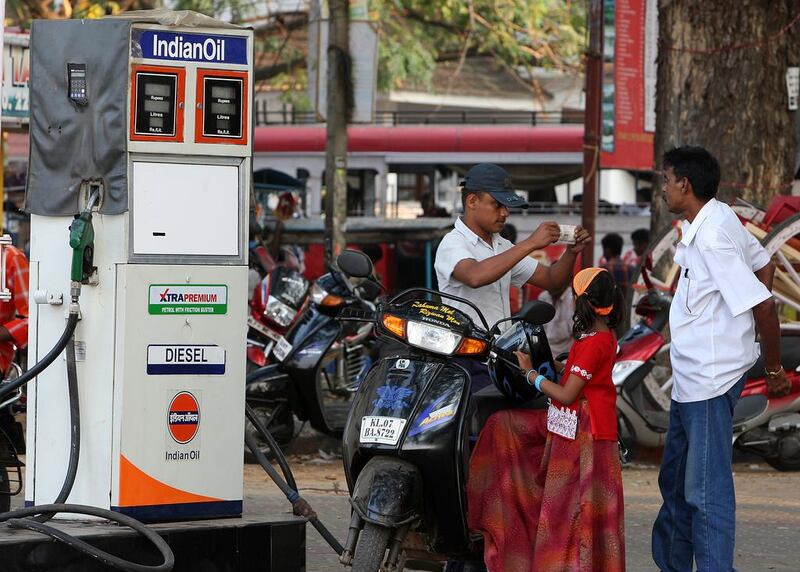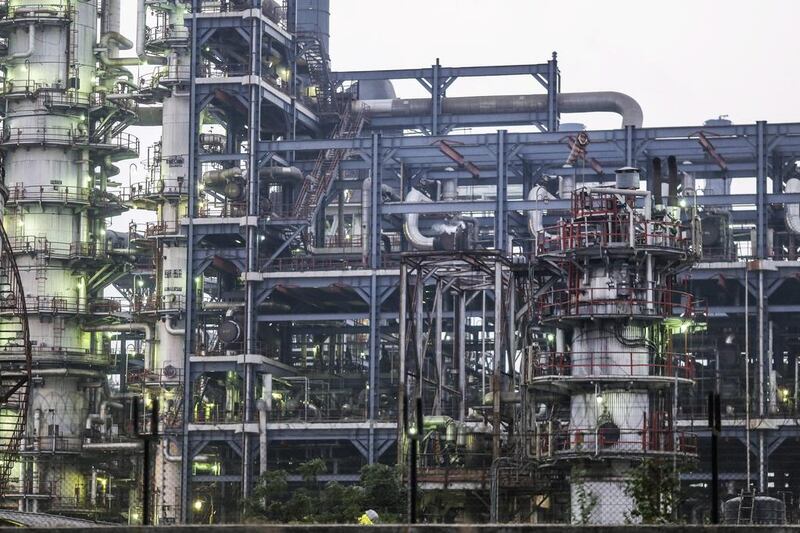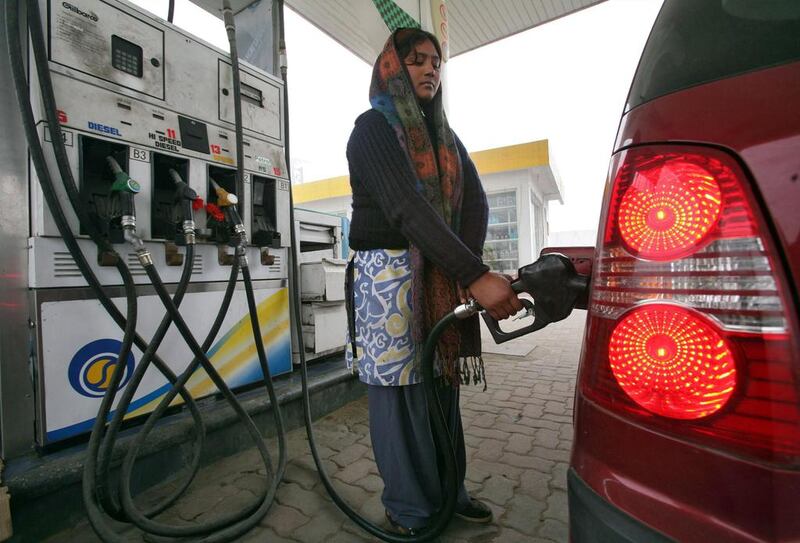Fahad Khateeb, who runs a business in Mumbai that manufactures LED lights, is constantly monitoring the price of oil because of the direct impact it has on his profits.
“Oil prices are the backbone of the Indian economy and India in the last few months has seen quite a bit of price rises of petrol and diesel, and we as manufacturers directly feel the impact as raw materials become more expensive in terms of transportation,” says Mr Khateeb, the chief executive of Indilights, who is worried over the impact of rising oil prices on his business.
India’s demand for oil is huge, as the world’s third-largest importer of crude oil globally. With consumption of oil expected to continue to surge over the coming years, it is becoming more crucial for India to look for ways to reduce price shocks and make sure it can source sufficient quantities of crude to meet its requirements.
“On the basis of per capita domestic consumption, India’s crude demand is expected to roughly increase by 50 per cent every decade,” says Abhay Bhargava, the regional head of energy and environment practice at Frost & Sullivan.
“Oil accounted for over 25 per cent of India’s total primary energy supply in 2016, with over 40 per cent powering the transport sector.”
A burgeoning population, rising incomes and the expansion of manufacturing sector are factors that are driving a surging demand for oil. Refineries which buy imported crude and then export their refined products are particularly heavy consumers of oil in India.
India’s consumption of oil hit a record high last year at 196.5 million tonnes, up 11 per cent on the previous year, according to government figures. Increased use of vehicles, including cars and motorbikes, played a major role in the rise, with demand for petrol up 12 per cent and diesel up 5.6 per cent.
India’s expanding appetite for oil is set to continue this year, with energy information provider S&P Global Platts forecasting that consumption of oil will increase by 7 to 8 per cent in 2017, outpacing China’s growth in demand for the third year in a row.
“The government’s clean fuel drive, sharp anticipated growth in transport demand and air travel, and the country’s insatiable growth for petrochemicals will act as a boon for gasoline, jet fuel, LPG and naphtha, helping oil products to post close to double-digit growth in 2017,” according to Platts.
To meet its thirst for oil, India is heavily reliant on imports for the vast majority of its supplies. This means that imports weigh heavily on India’s fiscal and current account deficits. India has benefited over the past couple of years from the slump in oil prices, with lower oil prices freeing up more money for the country and helping to cool inflation. But any rise in prices hits the country hard, with about 80 per cent of its oil demands met by imports.
“India’s reliance on oil imports rises above 90 per cent by 2040, requiring constant vigilance as to the implications for energy security,” according to the International Energy Agency (IEA), which projects that India will be the fastest growing crude consumer in the world. It expects crude imports to rise to 7.2 million barrels per day (bpd) in 2040, second only to China, sourced predominantly from the Middle East.
But prime minister Narendra Modi has set a target of reducing dependence on oil and gas imports by 10 per cent by 2022.
Mr Bhargava explains that “the unpredictability and strain on the national budget, owing to wide fluctuations in crude oil prices that are typical of this industry” are a major challenge for India, along with “a looming threat of supply disruption”.
“Owing to this, India has been challenged to mitigate by investing in storage facilities, which led to an initiative and roll out like the ISPRL [Indian Strategic Petroleum Reserves Ltd],” he says. “This in itself brings in considerable challenges, related to parking of considerable forex into strategic reserves, as well as capital spend on building the infrastructure.”
Along with storage facilities, Mr Bhargava says that other strategies that India is taking to be able to feed its energy needs include encouraging production of domestic crude with various policy initiatives.
“To sustain the growing demand for oil and to de-risk itself from increasingly volatile global markets, India has identified few major priorities for the oil and gas upstream segment which include diversifying supply sources for crude oil, acquisition of equity in oil and gas assets outside India, increasing the share of natural gas in the country’s primary energy basket, and aggressive application of improved oil recovery and enhanced oil recovery techniques.”
The ISPRL is a special purpose vehicle set up by India’s government to establish 5 million tonnes of strategic crude oil storages on the east and west coast of southern India in Visakhapatnam, Mangalore and Padur, to serve as a cushion during any disruption to supplies, at a total cost of more than 40 billion rupees (Dh2.15bn). The storages are built in underground rock caverns. India’s oil minister Dharmendra Pradhan has talked about setting up more such facilities. Last February, during the visit by Sheikh Mohammed bin Zayed, Crown Prince of Abu Dhabi and Deputy Supreme Commander of the Armed Forces, to India, Mr Pradhan said Abu Dhabi’s Adnoc had agreed to store crude oil in the reserves. There are hopes that with the Crown Prince scheduled to visit India on Thursday for Republic Day, plans for the UAE to provide oil for the strategic reserves might be boosted.
In September, Reuters reported that India had turned to Iran to buy 6 million barrels of crude for its strategic reserves.
India has been increasing its oil imports from Iran after western sanctions were lifted a year ago. In 2016, India’s oil imports from Iran hit their highest levels in at least six years. India bought 473,000 bpd of oil from Iran last year compared to 208,300 bpd in 2015, according to figures from Thomson Reuters Oil Research and Forecasts. In December, imports from Iran reached 546,600 bpd. Iran is now the fourth biggest supplier of oil to India, while it was in seventh place in 2015. Before sanctions were imposed, Iran was India’s second largest supplier of oil.
“India traditionally has been a net importer of oil for taking care of its fuel needs and a rise in international crude oil prices inflates its oil import bill, exerting a negative pressure on its forex reserves,” says Areef Patel, the vice chairman of Patel Integrated Logistics. “However, India has forged supply agreements with African oil-producing countries on a long-term basis and with Iran, India’s fuel supply position is in a comfortable space.”
Beyond that, some experts say that India should look at reducing it consumption of oil by turning to alternative energy sources.
India is already focusing developing on renewable energy sources, including solar and wind.
Sohinder Gill, the director of corporate affairs of the Society of Manufacturers of Electric Vehicles, explains that more needs to be done to reduce the use of oil in the country.
“The government aims at reducing oil imports by 10 per cent by 2022. But it looks like a distant dream as petrol and diesel vehicle sales in India are ever-increasing and hence one of the major factors for soaring oil demands.”
He adds that the Indian government should focus on alternative solutions to lower its dependence on oil.
“Instead of betting on LNG, CNG, hybrid or even BS VI [Bharat Stage emissions standards] compliant vehicles, there should be a greater push towards the adoption of electric vehicles. Two-wheelers form the major chunk of India’s vehicle population and effective steps for conversion of two wheelers to electric is the need of the hour.”
business@thenational.ae
Follow The National's Business section on Twitter








